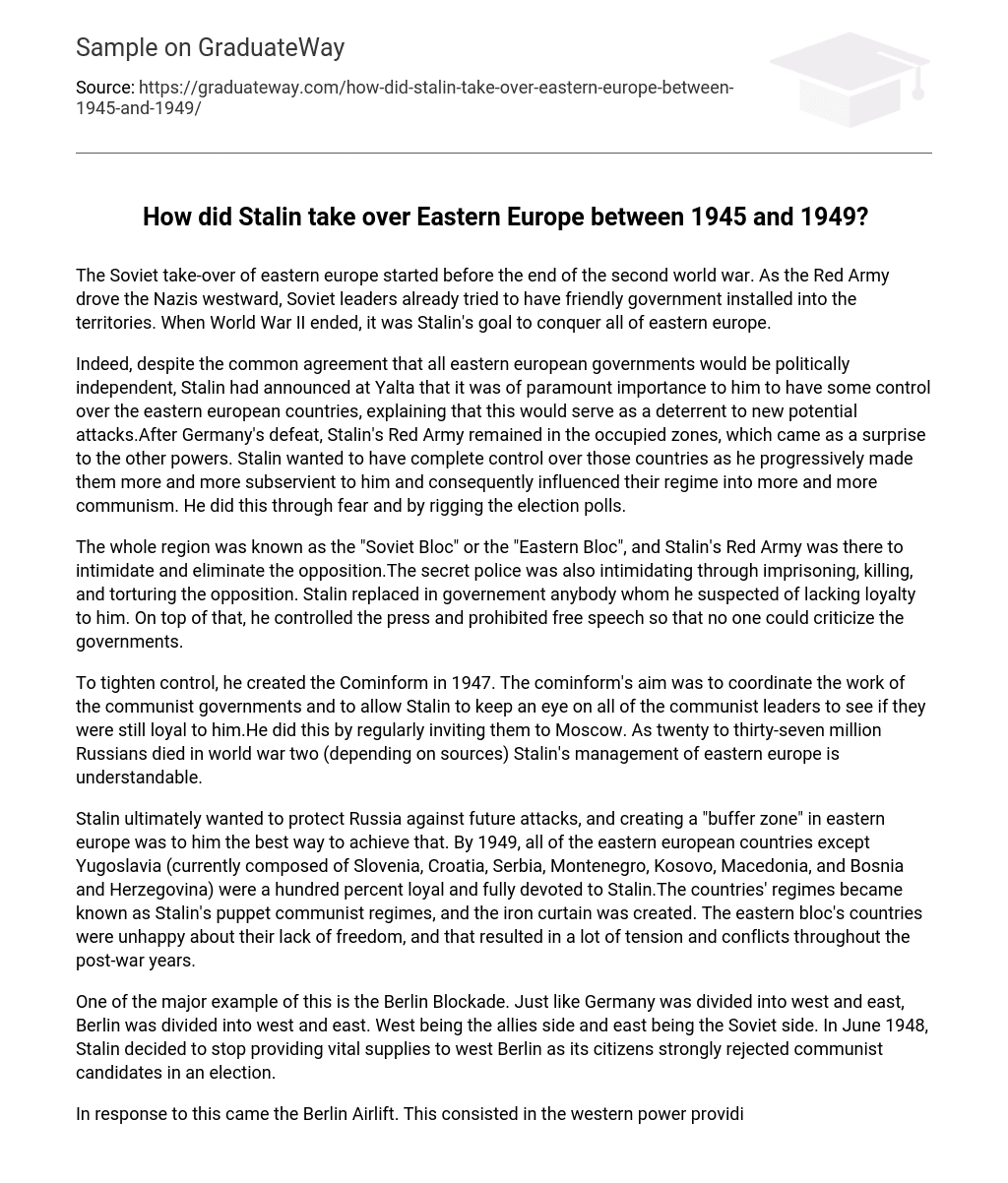The Soviet Union initiated invasions of eastern Europe before the conclusion of World War II. Alongside pushing the Nazis towards the west, Soviet leaders aimed to establish amicable governments in these regions. Stalin’s ultimate objective following the war was to gain dominion over all of eastern Europe.
Despite the consensus for political autonomy in eastern European governments, Stalin declared at Yalta the significance of maintaining some level of control over these nations, as a deterrent against potential attacks. Following Germany’s downfall, Stalin’s Red Army continued to occupy the conquered territories, catching other powers off guard. Stalin aimed to establish absolute dominance over these countries and gradually subjected them to his influence, ultimately steering their regimes towards communism. His tactics involved instilling fear and manipulating election polls.
The entire region was referred to as the “Soviet Bloc” or the “Eastern Bloc,” with Stalin’s Red Army present to instill fear and eradicate opposition. The opposition faced intimidation from the secret police, who employed imprisonment, murder, and torture. Stalin replaced any individuals in the government whom he suspected of disloyalty towards him. Additionally, he maintained control over the press and forbade freedom of speech to prevent any criticisms towards the governments.
Stalin established the Cominform in 1947 with the aim of enhancing control and coordination among communist governments. Its main purpose was to enable Stalin to closely observe the loyalty of communist leaders. As part of this strategy, he regularly invited them to Moscow. Considering the significant number of Russian casualties during World War Two, estimated between twenty and thirty-seven million by various sources, it is understandable why Stalin was determined to effectively supervise Eastern Europe.
Stalin aimed to safeguard Russia from potential attacks by establishing a “buffer zone” in eastern Europe. By 1949, all eastern European countries (excluding Yugoslavia) had pledged their complete allegiance to Stalin and his communist governments. This resulted in the creation of the iron curtain. Nevertheless, the absence of freedom in these nations generated tension and conflicts during the post-war era.
The Berlin Blockade exemplifies a significant division, as Germany and Berlin were both split into west and east. The western region aligned with the allies while the eastern region aligned with the Soviet Union. In June 1948, Stalin chose to halt crucial supplies to west Berlin due to its citizens’ strong rejection of communist candidates in an election.
The Berlin Airlift was a response to provide the necessary resources to the western Berliners by the western powers, using planes. Stalin, in order to prevent a potential escalation of violence and war, halted the airlift after nine months. Another example of Stalinist influence in eastern Europe was seen in Hungary with Matyas Rakosi.
In the 1945 elections, the non-communists emerged victorious and Tildy became the president. Nonetheless, Rakosi, the communist president of the secret police, chose to imprison and execute all non-communist adversaries. By 1948, Rakosi had established full dominion over Hungary and employed severe tactics in both internal politics and the economy.
His dictatorship in eastern Europe was one of the harshest. From 1948 to 1956, around 350,000 officials and intellectuals in Hungary who posed a potential threat were purged. Albania was seized without any resistance, while in Bulgaria, a communist government was elected in the 1945 elections and subsequently executed those who were not communists.
In 1949, the German Democratic Republic and East Germany transformed into a communist-controlled state. Romania underwent a similar transformation through the 1945 elections, resulting in the abolishment of the monarchy in 1947. Poland also experienced communists’ triumph in the 1947 elections, leading to the persecution and imprisonment of numerous non-communist individuals.
Following the war, Czechoslovakia was under the rule of a coalition comprising communist and non-communist factions. President Benest led the non-communists, while Prime Minister Gottwald represented the communists. In the 1946 elections, despite only receiving 38 percent of the votes and not securing a majority, the communists maintained authority over significant institutions like the radio, army, and police.
After assuming the role of prime minister a few years prior, Gottwald established the secret police which led to the arrests of non-communists. Following the manipulated elections in 1948, which resulted in the communists gaining the majority, Gottwald became president and assumed leadership of the new communist state. Numerous non-communists were either apprehended or executed, while non-communist foreign minister Masaryk tragically took his own life.
After the Soviet takeover of Eastern Europe, following Czechozlovakia, the Russian people believed that they had played a major role in defeating the Germans during World War two. Although they acknowledged the assistance of their allies, the Russians felt that they were predominantly responsible for the victory. This sentiment was justified as 80% of the German casualties occurred on the eastern front, and it was the Russian army that first reached Berlin. With this perspective, the Russians likely believed that they had the authority to mold the future of Europe.
Furthermore, Russia has faced multiple attacks from the west in the past. Specifically, in 1914 and 1941, Germany launched attacks on Russia by going through Poland. Stalin considered these historical events as reliable indications of potential future threats. In his view, gaining control over eastern Europe would greatly weaken this perceived threat.
In spite of this, it was decided at the Yalta conference, with Stalin’s approval, that all nations freed from Nazi Germany would have the opportunity to establish democracies and be politically autonomous. Clearly, Stalin failed to honor this commitment. Nonetheless, could it be argued that he wasn’t entirely at fault, as it had been agreed at Yalta that governments in eastern Europe would be “friendly” towards the Soviet Union?





